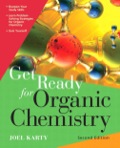
Concept explainers
Interpretation:
Whether the given hypothetical compound can act as soap is to be determined.
Concept introduction:
Soaps are sodium or potassium salts of fatty acids. They are ionic molecules that contain a hydrophilic group at one end and a hydrophobic group at the other end of the molecule. The hydrophobic end is typically a hydrocarbon group with a 12 to 18 carbon chain. It interacts with nonpolar substances like dirt, grease, and oil, bonding strongly because they are also nonpolar. The hydrophilic end is the carboxylate ion, a polar group that forms strong dipole-dipole interactions as well as hydrogen bonds with water.
An oil droplet for example, will dissolve the hydrophobic tail of the fatty acid anions, and be surrounded by them. The polar carboxylate groups of the soap molecules will be on the outside of this droplet and will interact strongly with water molecules, forming an emulsion, which can then be washed off by excess water.
Want to see the full answer?
Check out a sample textbook solution
Chapter 2 Solutions
EBK GET READY FOR ORGANIC CHEMISTRY
- Give detailed Solution with explanation needed with structure..don't give Handwritten answerarrow_forwardPlease explain option 3 with example.How is it possible?arrow_forwardIn this chapter, we did not discuss the interaction that is primarily responsible for the attraction that exists between an anion like CH30¯ and a nonpolar molecule like Br2. (a) What name would be ascribed to the strongest interaction that exists between those two species? (b) For which pair of species would you expect that type of attractive interaction to be stronger: between CH30¯ and Br2 or between CH30¯ and I2? Why?arrow_forward
- Show how methyl amine, shown below, can hydrogen bond to other methyl amines by clearly drawing in the hydrogen bond(s) and other methyl amine compounds.arrow_forwardThe compound WH2(C5H5)2 acts as a base, but TaH3(C5H5)2does not. Explain.arrow_forwardDraw a resonance structure, complete with all formal charges and lone (unshared) electron pairs, that shows the resonance interaction of the oxide with the para position in phenoxide ion. (please show which structure I need to put in the picture as my answer).arrow_forward
- 3. Answer ALL parts of this question "Surfactant" is a portmanteau -a word that is a contraction using parts of two or more other terms. What are the words that combine to form (a) 'surfactant'? Utilising a classification system that is based on chemical structure, identify any ONE type of surfactant. There is no need to identify a particular molecule or give a structure. (c) Identify and briefly evaluate a problem found with this type of sufactantarrow_forwardPlease don't provide handwritten solution .....arrow_forwardchoose either Soluble or Non-soluble, please explain each, no copy from previous answer, it's second time askingarrow_forward
- Please explain.arrow_forwardDetergents need not be ionic. Pentaerythrityl palmitate (shown here) is a nonionic detergent used in dishwashingliquids.(a) Identify the hydrophilic and hydrophobic portions of the molecule.(b) Draw a depiction of a micelle that would form if this compound were dissolved in water.(c) What intermolecular interactions are primarily responsible for the micelle’s solubility in water?(d) What advantages do nonionic detergents have over ionic detergents in hard water?arrow_forwardGive a clear handwritten answer with explanation...Blance the following reaction in detailed?arrow_forward
 Chemistry for Today: General, Organic, and Bioche...ChemistryISBN:9781305960060Author:Spencer L. Seager, Michael R. Slabaugh, Maren S. HansenPublisher:Cengage Learning
Chemistry for Today: General, Organic, and Bioche...ChemistryISBN:9781305960060Author:Spencer L. Seager, Michael R. Slabaugh, Maren S. HansenPublisher:Cengage Learning Organic Chemistry: A Guided InquiryChemistryISBN:9780618974122Author:Andrei StraumanisPublisher:Cengage Learning
Organic Chemistry: A Guided InquiryChemistryISBN:9780618974122Author:Andrei StraumanisPublisher:Cengage Learning

